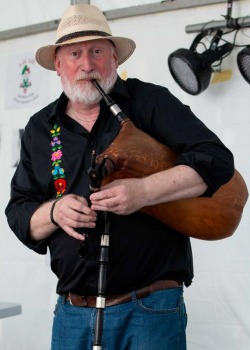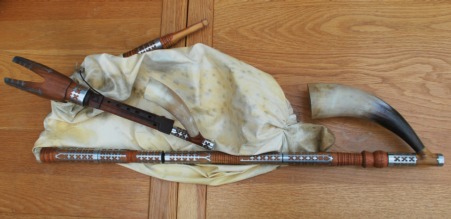The Bagpipe Society
A Hungarian Fascination

In the 1970s and 1980s the duo called Rebec were playing the English folk club and festival circuit. Bob Cross wrote the songs in the renaissance style reminiscent of the love songs of Elizabethan songwriter and lutenist, John Dowland. I was the other half of the duo and my role was to provide recorders, crumhorns, bowed psaltery, glockenspiel and guitar. We also used bagpipes; Bob played Flemish pipes and Northumbrian smallpipes and I played the gaita Gallicia.
This started and fostered my love of the bagpipe and I eventually augmented my collection with the addition of bagpipes from Bulgaria, Scotland, England, Sweden, Russia, Lithuania, Germany, Italy, Greece, Serbia, Croatia, Turkey, Bohemia, Tunisia and Hungary. (the Breton biniou is on order)
It is the music of Hungary that has, over the years, had the main attraction for me and this started back in the mid to late 1980s when I produced and presented the weekly folk programme on BBC Radio Manchester. It was, in fact, the American record producer Joe Boyd who brought the music of Hungary to the attention of British folk audiences when he released albums by Muzsikas and Marta Sebestyen on his Hannibal record label amnd I played their records and even interviewed the band on the show. I saw the group at The Band on The Wall in Manchester, as well as Sidmouth Folk Festival and Fairport Convention’s Cropredy festival.

Rebec were invited to represent England at the Interfolk Festival in Budapest in 1990. The Northumbrian smallpipe player Kathryn Trickell was also on the bill representing England.
So, my interest in Hungarian traditional music was well and truly developed but it wasn’t until some twenty seven years later that a chance meeting with a Hungarian female singer and musician at the Gobefest Hungarian and Transyllvanian festival in Manchester in 2017 rekindled my interest. The musican was Ildiko Csige from Debrecen in the east of the country. We have now established an Anglo-Hungarian act and, between us, we play citeras (zithers), tekeros (hurdy-gurdies), furulyas (wooden fiple flutes), utogardon (percussion), koboz (lute) and, of course, the Hungarian bagpipe known in Hungary as the Magyar duda.
The Hungarian bagpipe has a diple (ie: twin bore) chanter, one of which gives a variable drone. There is also a bass drone. The chanter has the characteristic and traditional addition of a carved wooden goat’s head on the headstock, often inlaid with pewter. This is to reflect the fact that the instrument’s bag is made from a whole goat with the chanter being tied into the neck and the forelegs accomodating the chanter and blow-pipe.
Another characteristic feature is the use of the “kontra” to provide rhythmic accompaniment and to vary the sound of the drone. The chanter has a “flea-hole”, a common feature of Eastern European bagpipes. This flea-hole, the top hole on the chanter, is a very small hole and uncovering it raises the pitch of any other note by approximately a semi-tone making the instrument largely chromatic over its range.

My two sets of Hungarian duda are extremely fine instruments. Balazs Istvanfi made my Bb set in 2010. They are made from African blackwood and have a modern design. Balazs lives and works in Zebegeny just north of Budapest. Andor Vegh made my set in A and they are more traditional in appearance. They were especially made for me in 2018 and are constructed from plum wood with traditional design pewter inlays along the chanter, headstock, chanter and blow-pipe. They incorporate the traditional upturned cow horns on the chanter and bass drone. Andor lives and works in Pecs in the south of Hungary.
Selected discography:
Toronyalja ( Mixolyd) Balazs Istfanfi
I Can See The Gates Of Heaven (Woprld Village) Marta Sebestyen with Balazs Szokolay Dongo and Matyas Biolya
The Prisoner’s Song (Hannibal) Muzsikas
Vasmalom II (MW Records) Vasmalom
Magyar Dudasok (Teka) Various Artists
Vizonto (FM) Vizonto
Bekesseg (TRAX) Makvirag
By Billington, Mike Trad Various
From Chanter Spring 2019.
- Data Processing Notice (GDPR)
-
@BagpipeSociety on X (formally known as Twitter)
-
TheBagpipeSociety on Instagram
-
 BagpipeSociety on Facebook
BagpipeSociety on Facebook
Something wrong or missing from this page? Let us know!
